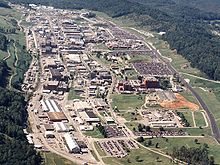Mercury Releases at the Y-12 Site

Aerial Photo of Y-12 Facility
Public Health Assessment
- Evaluation of Y-12 Mercury Releases [PDF, 10.91 MB]
From 1950 to 1963, the Y-12 plant (now known as the Y-12 National Security Complex) began separating high-purity lithium 6 from natural lithium to produce enriched lithium 6 deuteride for hydrogen bombs. Pilot scale tests at the Y-12 Plant between 1950 and 1955 investigated alternate processes for separating lithium isotopes. The Y-12 plant used two full-scale production processes to make high-purity enriched lithium 6 deuteride:
- Elex (electrical exchange) process from August 1953 to 1957
- Colex (column exchange) process from January 1955 to May 1963.
These two lithium separation processes required the use of large quantities of elemental mercury which resulted in the off-site releases of mercury to the air in Bear Creek Valley and to the water and soil in the East Fork Poplar Creek floodplain.
After 1963 the Y-12 plant post-production activities were only responsible for relatively small mercury releases.
ATSDR’s Involvement
The Agency for Toxic Substances and Disease Registry (ATSDR) conducted a public health assessment to evaluate off-site residents’ exposure to Y-12 plant-related mercury from 1950 to 2009. ATSDR assessed the health effects for community residents possibly exposed to three forms of mercury (elemental, inorganic, and organic) in the
- air
- soil
- surface water
- sediment
- biota
- fish
- crawfish
- turtles
- produce.
The agency evaluated potential past and current off-site exposures to mercury in seven communities most likely to have been affected by the mercury releases. The communities included residents who lived in the
- city of Oak Ridge
- Scarboro neighborhood
- Wolf Valley
Others who might have been affected are residents who lived or recreated in or along the
- East Fork Poplar Creek floodplain
- Poplar Creek
- Clinch River
- Watts Bar Reservoir.
General Conclusions
ATSDR concluded that current exposure to mercury released from the Y-12 plant is not a public health hazard. Cleanup activities in the East Fork Poplar Creek floodplain soil were protective of public health.
Even with many uncertainties associated with past exposures to mercury, ATSDR concluded that some potential mercury exposures in the past may have resulted in harmful health effects as indicated below:
- From 1950 to 1963 elemental mercury could have been carried from the Y-12 plant by workers into their homes and potentially exposed their families to elemental mercury vapors and caused harm, especially to young children.
- Children who swallowed water while playing in East Fork Poplar Creek during specific weeks from 1956 - 1958 could have been exposed to levels of inorganic mercury that may have had kidney (renal) health effects.
- Children, who accidentally swallowed soil while playing in the in two areas along East Fork Poplar Creek floodplain before the removal of mercury-contaminated soil in 1997, could have been exposed to inorganic mercury that may have resulted in kidney (renal) health effects.
- Children born to or nursing from women who ate certain species of fish from Poplar Creek during the 1970s-1990s may have an increased risk of subtle neurodevelopmental health effects. For these risks to have occurred, mothers had to frequently eat certain species of fish just before and during pregnancy or while nursing.
ATSDR does not have enough information to determine whether people living off site could have been harmed from the following:
- breathing elemental mercury from 1950 through 1963
- swallowing water with inorganic mercury from East Fork Poplar Creek from 1953 to 1955
- eating fish with organic mercury during the 1950s and 1960s
Contact Us:
- Agency for Toxic Substances and Disease Registry
4770 Buford Hwy NE
Atlanta, GA 30341-3717 USA - 800-CDC-INFO
(800-232-4636)
TTY: (888) 232-6348
Email CDC-INFO - New Hours of Operation
8am-8pm ET/Monday-Friday
Closed Holidays


